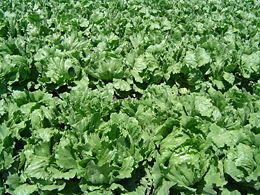Lettuce
2008/9 Schools Wikipedia Selection. Related subjects: Food; Plants
|
||||||||||||||||||||||||
|
||||||||||||||||||||||||
The Lettuce (Lactuca sativa) is a temperate annual or biennial plant of the daisy family Asteraceae. It is most often grown as a leaf vegetable. In many countries, it is typically eaten cold and raw, in salads, hamburgers, tacos, and many other dishes. In some places, including China, lettuce is typically eaten cooked and use of the stem is as important as use of the leaf. Both the English name and the Latin name of the genus are ultimately derived from lac, the Latin word for “milk”, referring to the plant’s milky juice. Mild in flavour, it has been described over the centuries as a cooling counterbalance to other ingredients in a salad. In his humorous essay 100 Things I Hate, filmmaker John Waters refers to iceberg lettuce as "the polyester of greens".
Description
The lettuce plant has a short stem initially (a rosette growth habit), but when it blooms the stem lengthens and branches, and it produces many flower heads that look like those of dandelions, but smaller. This is called bolting. When grown to eat, lettuce is harvested before it bolts. Lettuce is used as a food plant by the larvae of some Lepidoptera. The largest lettuce head, of the Salad Bowl cultivar, weighed 11 kg (25 lb) grown by Colin Bowcock of Willaston, England, in 1974.
Cultivation
Lettuce is grown commercially worldwide.
History
The lettuce that we see today actually started out as a weed around the Mediterranean basin. Served in dishes for over 4500 years, lettuce has certainly made its mark in history- as seen from tomb paintings in Egypt to the depiction of many different varieties in ancient Greek relics. Christopher Columbus introduced lettuce to the new world.
Cultivars
There are six commonly recognised Cultivar Groups of lettuce which are ordered here by head formation and leaf structure; there are hundreds of cultivars of lettuce selected for leaf shape and colour, as well as extended field and shelf life, within each of these Cultivar Groups:
- Butterhead, also called Boston or Bibb, forms loose heads; it has a buttery texture. Butterhead cultivars are most popular in Europe.
- Chinese lettuce types generally have long, sword-shaped, non-head-forming leaves, with a bitter and robust flavour unlike Western types, appropriate for use in stir-fried dishes and stews. Chinese lettuce cultivars are divided into “stem-use” types (called celtuce in English), and “leaf-use” types such as youmaicai (Chinese: 油麦菜; pinyin: yóumàicài) or shengcai (生菜).
- Crisphead, also called Iceberg, which form tight, dense heads that resemble cabbage. They are generally the mildest of the lettuces, valued more for their crunchy texture than for flavour. Cultivars of iceberg lettuce are the most familiar lettuces in the USA. The name Iceberg comes from the way the lettuce was transported in the US starting in the 1920s on train-wagons covered in crushed ice, making them look like icebergs.
- Looseleaf, with tender, delicate, and mildly flavoured leaves. This group comprises oak leaf and lollo rosso lettuces.
- Romaine, also called Cos, grows in a long head of sturdy leaves with a firm rib down the centre. Unlike most lettuces, it is tolerant of heat.
- Summer Crisp, also called Batavian, which form moderately dense heads with a crunchy texture; this type is intermediate between iceberg and looseleaf types.
Some lettuces (especially iceberg) have been specifically bred to remove the bitterness from their leaves. These lettuces have a high water content with very little nutrient value. The more bitter lettuces and the ones with pigmented leaves contain antioxidants.
Breeding
L. sativa can easily be bred with closely related species in Lactuca such as L. serriola, L. saligna, and L. virosa, and breeding programs for cultivated lettuce have included those species to broaden the available gene pool. Starting in the 1990s, breeding programs began to include more distantly related species such as L. tatarica.
Nutrition
Lettuce is a fat free, low calorie food. It is a valuable source of vitamin A and folic acid. Lactucarium (or “Lettuce Opium”) is a mild opiate-like substance that is contained in all types of lettuce. Both the Romans and Egyptians took advantage of this property eating lettuce at the end of a meal to induce sleep.
Religious restrictions
The Yazidi of northern Iraq consider eating lettuce taboo.

